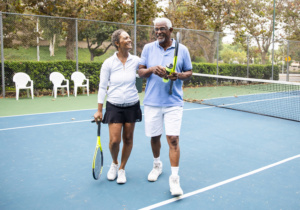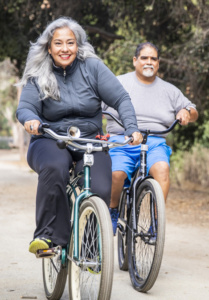Low Impact, High Success
Focus On The Right Kinds Of Exercise After Age 50
Article By Erik J. Martin, CTW Features
Want to enjoy a longer lifespan and continue partaking in most of the activities you love, with less pain, fatigue and frustration? There is no magic pill, operation or trendy diet that’s going to make it happen. Instead, this promise and possibility lie within you and the extent to which you’re willing to keep your body moving as the years advance, which is why fitness and exercise take on added importance as you age.
In other words, prepare to “use it or lose it,” say the experts.
“As the body ages, it undergoes changes in composition, including a profound change in muscle loss—especially in inactive people. In fact, over age 40, our bodies can begin to lose up to 8 percent of muscle mass every decade,” says Brian Cole, MD, a Chicago-based orthopedic sports medicine surgeon and team physician for the Chicago White Sox and Chicago Bulls. “Other challenges for aging adults are reduced strength and endurance, slower recovery and increased soreness. Plus, the ability to digest protein and absorb amino acids—key ingredients in building and maintaining muscle mass—is blunted in older adults.”
The good news is that proper fitness can improve these and other side effects of aging.
“People over 50 need to promote vascular health, maintain weight and avoid cardiovascular risk factors,” suggests John Higgins, MD, a sports cardiologist at the University of Texas Health Science Center at Houston. “And it’s never too late to start to exercise.”
Judy Gaman, CEO of Executive Medicine of Texas and co-host of the Stay Young America! podcast, says stepping up your exercise efforts pays off.
“Multiple studies show that exercise improves memory function and mood while decreasing pain. This makes engaging in fitness activities especially important to people over age 50,” says Gaman.
Older Americans are sometimes fearful of causing injury by “overdoing” it or exercising incorrectly. But a common-sense approach—and a thumbs up from your physician—can prevent harm and lead to better results.
“It’s important to check with your doctor before starting a new exercise routine to make sure your heart, lungs and other systems are medically fit for the activity. And it’s wise to consider activities that involve less impact or risk of injury as we age,” explains John-Paul Rue, MD, orthopedic surgeon and sports medicine specialist at Mercy Medical Center in Baltimore.
Melissa Morris, an exercise physiologist and nutritionist in Tampa, says a good rule of thumb is to follow the Department of Health and Human Services’ 2018 Physical Activity Guidelines, which calls for 150 minutes of aerobic or cardiovascular activities weekly and at least two muscle-strengthening sessions a week.
“The 150 minutes can be broken up into 30 minutes over five days, or whatever is appropriate,” notes Morris.
Rue agrees.
“Aim for 30 minutes of exercise where you sweat, five times a week,” says Rue. “I’m a big fan of walking and cycling. The former is easy, doesn’t require any additional equipment, and can be a form of social activity. And cycling is easier on your body than running but still provides a great cardio workout.”
Water aerobics is a great activity for adults in their 70s and 80s, especially for those with aching joints, Rue adds.
Higgins advises eschewing high-intensity workouts that may involve squatting, lunging and jumping as well as heavy weight-resistant exercises that can result in muscle and joint injuries or bone fractures.
“Try to use lighter weights with more reps, and opt for low- to moderate-intensity exercises,” says Higgins.
Before initiating any fitness routine, engage in best practices, too.
“Take the time to warm up and stretch before exercising. Focus on form and technique over speed or weight. Start slow and low, gradually progress, and don’t overdo it—listen to your body,” Rue suggests.
Higgins says it’s also crucial to invest in the right equipment—including appropriate and comfortable shoes. Pick the best environment, too—whether it’s the local gym or a YMCA class. Also, consider enlisting a coach or trainer or at least an exercise buddy who can motivate you to stay on schedule, exercise safely and give your muscles 48 hours to recover.
“Say you cycle on Mondays, Wednesdays and Fridays. If so, spend Tuesdays and Thursdays working on something else, like resistance training,” adds Higgins. He also recommends adding in some balance and flexibility training too, “which has been shown to boost stability and reduce falls.”
Lastly, don’t overlook other ways to ensure a healthier lifestyle.
“Diet always goes hand in hand with physical activity, so make sure you consume plenty of protein and fiber,” Morris says. “Also, take appropriate vitamin and mineral supplements, stay hydrated, shoot for eight hours of sleep a night and lower your stress levels through mediation and relaxation.”
CTW Features

